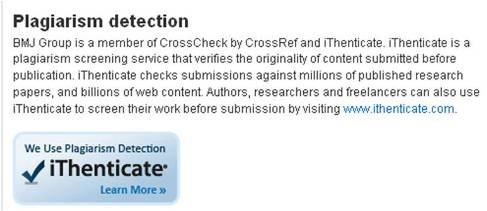Plagiarism detection: CrossRef, CrossCheck and iThenticate
12 Jun, 12 | by BMJ
Most authors are aware that plagiarism is an unethical publication practice. However, it is still a serious problem and arguably the most common ethical issue afflicting medical writing.
The World Association of Medical Editors (WAME) defines plagiarism as:
Plagiarism is the use of others’ published and unpublished ideas or words (or other intellectual property) without attribution or permission, and presenting them as new and original rather than derived from an existing source. The intent and effect of plagiarism is to mislead the reader as to the contributions of the plagiarizer.
 Over the past few years, many publishers (including BMJ Group) have been trialling CrossCheck, a plagiarism checking service launched by CrossRef; a non-profit collaboration of 3887 commercial and learned society publishers. The strength of the service (which uses the iThenticate plagiarism software) is the size of its database of articles, against which other articles are compared. It is a condition of subscription that publishers deposit their articles into this database, which explains the sheer scale of it.
Over the past few years, many publishers (including BMJ Group) have been trialling CrossCheck, a plagiarism checking service launched by CrossRef; a non-profit collaboration of 3887 commercial and learned society publishers. The strength of the service (which uses the iThenticate plagiarism software) is the size of its database of articles, against which other articles are compared. It is a condition of subscription that publishers deposit their articles into this database, which explains the sheer scale of it.
Some of the figures from publishers testing the service were perturbing. For example, Nature reported that:
Taylor & Francis has been testing CrossCheck for 6 months on submissions to three of its science journals. In one, 21 of 216 submissions, or almost 10%, had to be rejected because they contained plagiarism; in the second journal, that rate was 6%; and in the third, 13 of 56 of articles (23%) were rejected after testing, according to Rachael Lammey, a publishing manager at Taylor & Francis’s offices in Abingdon, UK.
By partaking in the CrossCheck initiative, BMJ Group compares all accepted manuscripts to the CrossCheck database using iThenticate. The system produces an overall similarity score, which is flagged to our editorial staff if significantly high. In such instances, we then assess each instance highlighted in the summary report to determine its significance. We have also recently added the ‘We Use Plagiarism Detection’ badge to all of our instructions for authors in a bid to deter authors up-front from submitting work that contains forms of plagiarism.